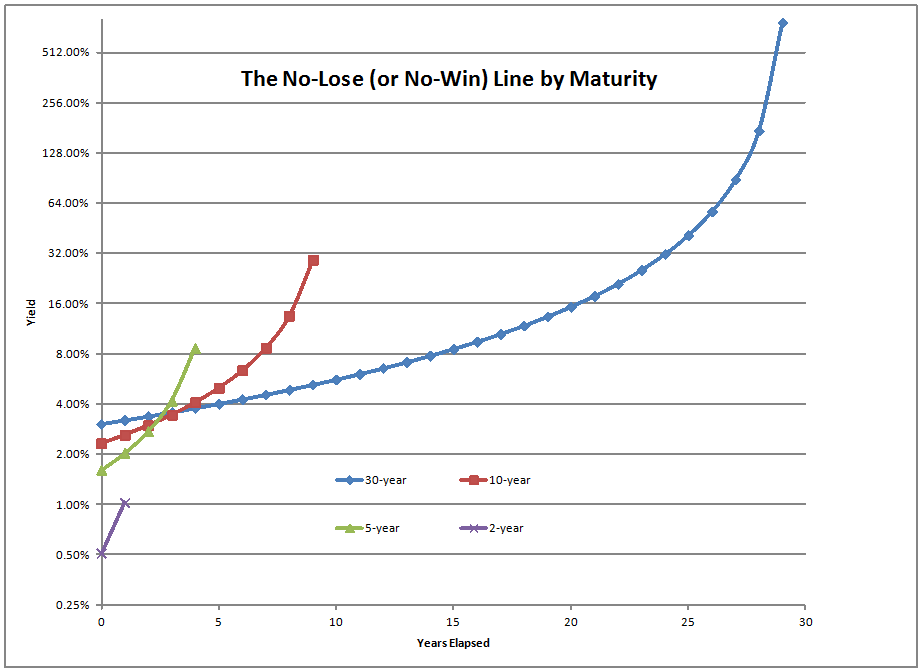 How long can you hold a Treasury Note or Bond, and not suffer a loss in total return terms, if yields rise from where they are today? ?Maybe the answer will surprise you, and maybe not — it depends on how fixed-income literate you are.
How long can you hold a Treasury Note or Bond, and not suffer a loss in total return terms, if yields rise from where they are today? ?Maybe the answer will surprise you, and maybe not — it depends on how fixed-income literate you are.
Okay, here’s the scenario: I start off with the current yield curve for 2-, 5-, 10-, and 30-year Treasuries (0.51%, 1.61%, 2.32% and 3.04%). ?I make the following assumptions:
- Annual Coupon Payment at the end of the year (at the current bond equivalent yield)
- The bonds are priced at par, so they are current coupon bonds.
- They are new bonds with the full maturity to go.
- Each year, the coupon payment is reinvested in bonds of the same type.
- Each scenario is run until there is one year left to go. ?The rate in the last year is the total return earned in the scenario if the notes/bonds pay off.
- I’m not considering inflation, so these will be real losses if inflation is positive on average.
- Those that hold don’t need to earn any income, unlike insurers, banks, pension plans and endowments. ?We could do the same analysis for them, but the lines would look flatter, because they can’t afford to lose as much.
So, what higher yield rate on the bonds will make the total return zero as the years elapse? ?That’s what the above graph shows… so what can we learn from that?
For 5-,10- and 30-year Treasuries, a yield rate near 3.03% will hold the package to roughly a zero total return after 2?years. ?After 3?years, that same figure is around 3.74%.
As time elapses, scenarios above the lines would represent losses on a total return basis, and below the line would be gains. ?The path itself would matter a little, but?the latest position more. ?The graph can be used in another way also… if you have an idea of how high you think interest rates will go, you will have a have an idea of how long it would take to break even. ?Remember, if the Treasury is “money good,” you get it all back at the maturity of the note/bond.
Or, if you are holding bonds for a little while, if you think the stock market is too high, this can give you an idea on how long?to buy the bonds if you don’t want to take losses if you decide to reinvest in stocks. ?(Yes, I know… in a hard down market, you will likely be grateful that you held the Treasury notes/bonds. ?That is, unless the US Dollar is no longer viewed as a reliable international store of value… and then we will have bigger fish to fry.)
The main lesson: choose your maturity preference with care for slack balances that you don’t want to invest in risk assets… you get more yield as you go longer, but the longer bonds lose money more rapidly for a given rise in interest rates.
Final notes: the lines are a little cockamamie at the end — they aren’t wrong, but the economic scenario producing such a path of interest rates would imply very high inflation or capital scarcity — the latter would tank the stock market as well, at least in the short run, and the former might tank the dollar, or lead to a run in commodities.
Those scenarios are also unusual because they highlight how bond investors investing to a fixed term earn more reinvesting coupon payments in a rising interest rate environment. ?At least that is true nominally prior to taxes and inflation, but those are separate issues.
All for now. ?Thanks for reading.
